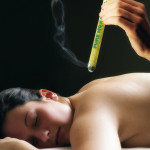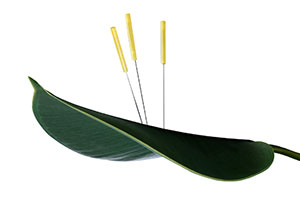So what is Moxibustion?

 Moxibustion (or Moxa) is a common TCM practice that can be used on its own or to complement other Chinese treatments. It plays an important role in the practice of TCM in China, Japan, Korea, Vietnam, Tibet, and Mongolia. The herb involved in this treatment is the dried shredded “wool” of the Mugwort plant, Artemisia vulgaris.
Moxibustion (or Moxa) is a common TCM practice that can be used on its own or to complement other Chinese treatments. It plays an important role in the practice of TCM in China, Japan, Korea, Vietnam, Tibet, and Mongolia. The herb involved in this treatment is the dried shredded “wool” of the Mugwort plant, Artemisia vulgaris.
Moxa is seen as yang in nature meaning that it is a source of heat energy. It is used, therefore, to rebalance stagnant conditions that lack both yang and heat because it expels cold and dampness. Indeed, Moxa treatment is both comforting and relaxing. It delivers a sensation of warmth (heat) as it eliminates stagnancy and it establishes better circulation by stimulating blood and Qi flow, opening channels and warming meridiens, and strengthening the immune system.
Terms such as stagnancy, heat and cold are unusual considerations in current Western medicine but this was not always the case. Only as little as a few centuries ago, in the days of Dr Johnson, maladies were discussed in terms of “humours” and reference was made to cold and damp as well as biles, blood and phlegm. Today, possible theories for the effects of Moxa propose that heat stimulation causes blood vessels to relax and open in the area where Moxa is applied. At the same time, it activates sensory nerves lying under the skin that, in turn, stimulate nerve cells to release pain-killing substances such as endorphins etc.
Whereas acupuncture stimulates both the blood and nerve circulatory systems, moxibustion does this and provides added energy in the form of heat. So when an individual is quite weak, Moxa complements acupuncture's therapeutic effects when a strong positive response is needed.
Conditions treated by Moxa include: cold or heat deficient spasm and pain, chronic problems typical of old age, poor circulation, rheumatic pain, asthma, diarrhoea, abdominal pain, vomiting, and certain female disorders (improving fertility).
Moxibustion – the process
- Moxibustion is delivered in a well ventilated space as it involves the slow burning of a herb rather like the burning of incense sticks. Small amounts of compressed mugwort which have been rolled into Moxa sticks, the shape and size of a cigar, are lit and the TCM-style practitioner, who uses the indirect method, will hold them above the skin or acupuncture needles for a few minutes at particular acupoints key for treating the condition
Sometimes, a small Moxa ball is rolled and placed on the head of an acupuncture needle before it is lit.
The small Moxa ball burns for between 20-30 seconds and is extinguished and this process may be repeated
for a prescribed number of times.
- This is in contrast to the direct method generally used by a 5-element acupuncturist, where Moxa cones are lit and applied to the body. The method used depends not only on the practitioner but largely on the sensitivity of the individual as well as the condition being treated.
- Moxa generates a mellow, warming sensation but a sharper but still pleasant sensation considered to be energetically, more powerful can be felt the closer the smoking Moxa approaches the skin.
- Moxibustion is usually administered between 10-30 minutes, depending on individual weakness and their condition.
Some interesting facts
- Medical historians believe that moxibustion was practiced before acupuncture, at least as long ago as 3000 years. Hieroglyphs of moxibustion and acupuncture marking bones and tortoise shell can be traced back to the Shang Dynasty.
- Mugwort has been used since ancient times as a remedy against fatigue. The Romans planted Mugwort along roadsides so that a passerbys (as well as soldiers) could insert this weed into their shoes to relieve aching feet.
- The term mugwort, in old English, means to ward off moths and refers to use of the herb to repel moths and other insects.
- Mugwort is also used as a bitter flavouring agent to season fat meat and fish.
